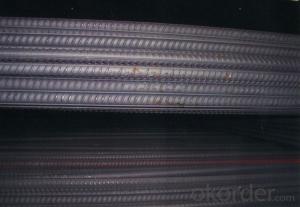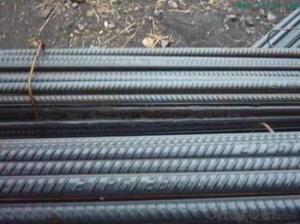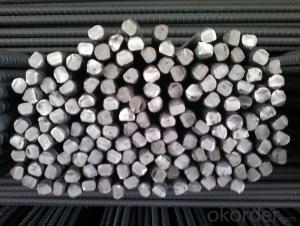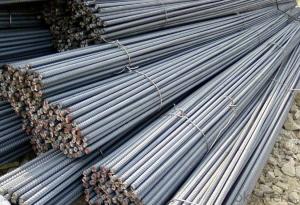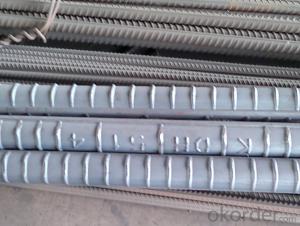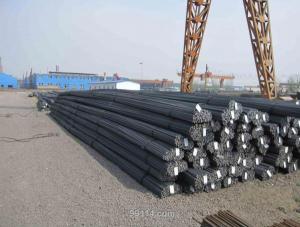Hot rolled ribbed steel bars (HRB400E-500)
- Loading Port:
- Tianjin
- Payment Terms:
- TT OR LC
- Min Order Qty:
- 1000 m.t.
- Supply Capability:
- 120000 m.t./month
OKorder Service Pledge
OKorder Financial Service
You Might Also Like
Reinforcing bar (Rebar) refers to the use of reinforced concrete and prestressed concrete with steel, its cross section is round, sometimes for the square with rounded corners. Including light round bar, ribbed steel bar, torsion bar. Reinforced concrete with steel bar is refers to the reinforced concrete reinforcement with straight or plate of strip steel, its appearance is divided into two kinds, light round steel and deformed steel delivery status for the straight bar and wire rod in two. Light round bar is really a small round steel and ordinary low carbon steel wire rod. Deformation is surface ribbed steel bar, usually with 2 longitudinal and cross rib of uniform distribution along the length direction. The appearance of cross rib is spiral, chevron, crescent 3 kinds. With nominal diameter mm number representation. Equals the nominal diameter is equal to the cross section deformation of reinforced light round bar nominal diameter. Reinforcement of nominal diameter is 8-50 mm, recommends to the diameter of 8, 12, 16, 20, 25, 32 and 40 mm. Steel grade: 20 mnsi, 20 mnsi MNV, 25, BS20MnSi. Rebar in concrete main tensile stress. Deformed bars as a result of the action of rib, and concrete have larger bonding ability, thus better able to withstand the role of external force. Steel is widely used in various building structures. Especially large, heavy, light thin wall and high-rise building structure.
Steel processing, steel processing to table and design review, check the material list for errors and omissions, for each steel bar to press
Material list to check whether meet the requirements, after these two checks, then press the material list sent out samples, trial production of qualified rear can batch production, processing and good reinforcement to neatly stacked in order.
Construction such as the need to be reinforced by substitution, must fully understand the design intent and substitution material performance, strictly abide by the current design code of reinforced concrete rules, not to area such as the substitution of low strength of high strength steel reinforcement. Any important parts of a reinforced substitution, shall agree with the consent of party a, design unit, and have a written notice shall be substitution.
(1) the steel surface should be clean, sticky oil, dirt, rust must be cleaned before use, can be combined with cold-drawn rust removal process.
(2) reinforced straightening, usable mechanical or manual straightening. After straightening of steel can not have local small bending, die bending, wavy, its surface scars should not be made of steel decreases by 5%.
(3) the steel bar cutting should be according to the number, diameter, length and quantity, the length is tie-in, first cutting long expected, by cutting short expected to reduce short head, and shorten the steel to save steel.
(4) steel hook or bend:
1) steel hook. There are three kinds of forms, respectively semicircle hook, hook and hook. After bending, bend endothelial contraction, skin
Extension, axis length is constant, bend arc formation, size is greater than the baiting size after bending, bending modifier should be considered.
Reinforced bending diameter of 2.5 d heart, straight part for 3 d. Steel hook increase the length of the theoretical calculation value: counter rotating round hook is 6.25 d, the straight
Hook is 3.5 d, the hook is 4.9 d.
(2) the bending of steel. Middle bending diameter D bend, not less than five times the diameter of the reinforcing steel bar.
(3) the stirrup. Stirrups should be done at the end of the hook, hook form should meet the design requirements. Stirrup adjustment, is the hook to increase the length and bending adjustment
Value or the difference between the two and, according to the amount of stirrup outsourcing size or inside the package size.
(4) reinforced blanking length should be according to the component size, concrete cover thickness, rebar bend modifier and hook to increase the length of the provisions as comprehensive exam
Lv.
A. straight reinforced blanking length = member length - protective layer thickness increase length + hook,
B. turn up steel blanking length = straight length - bend modifier + + inclined curved length increase length of hook,
C. blanking length = stirrup stirrup inner perimeter + modifier + hook to increase length of stirrup.
- Q: How are steel rebars stored on-site?
- Steel rebars are typically stored on-site in a horizontal position, either on racks or on elevated platforms, to prevent contact with the ground and minimize the risk of corrosion. They are often organized by size and type, and protected from the elements through the use of waterproof covers or tarps. Additionally, rebars should be kept away from moisture and excessive heat to maintain their structural integrity.
- Q: What are the guidelines for inspecting and testing steel rebars on-site?
- The guidelines for inspecting and testing steel rebars on-site typically include visually examining the rebars for any visible defects such as rust, cracks, or bends. Additionally, non-destructive testing methods like ultrasonic testing or magnetic particle inspection may be employed to detect any internal flaws or inconsistencies in the rebars. It is also crucial to ensure that the rebars meet the specified dimensions, lengths, and quality standards as per the project requirements. Regular sampling and testing of rebars are essential to maintain the structural integrity and safety of the construction project.
- Q: What is the purpose of using steel rebars in concrete structures?
- The purpose of using steel rebars in concrete structures is to enhance the overall strength and durability of the structure. Concrete, while excellent in compression, is weak in tension. By incorporating steel rebars into the concrete, the structure is able to resist tensile forces and prevent cracking or failure. Steel rebars, which are typically made of carbon steel, are strong and have high tensile strength. They are placed within the concrete forms before pouring, creating a reinforced concrete structure. When subjected to tensile forces, the concrete transfers the load to the steel rebars, which can resist the pulling or stretching forces. This reinforcement helps to distribute the load more evenly, preventing localized stress points and reducing the risk of structural failure. In addition to providing tensile strength, steel rebars also help to control cracks in concrete structures. As concrete shrinks and expands due to temperature changes or drying, it is susceptible to cracking. The presence of steel rebars helps to limit the width and extent of these cracks, ensuring the structural integrity and longevity of the concrete. Furthermore, steel rebars can improve the resistance of concrete structures to seismic activity or other dynamic forces. The flexible nature of steel rebars allows them to absorb and dissipate energy during earthquakes or other vibrations, reducing the risk of collapse. Overall, the purpose of using steel rebars in concrete structures is to reinforce and strengthen the concrete, providing additional tensile strength, controlling cracks, and enhancing the overall durability and resilience of the structure.
- Q: 12 of the threaded steel can replace 16 of the screw steel? But the same proportion. Thanks
- Now Tianjin Tiantai into 12 of the price is 3900 yuan a ton, 16 tons of steel a price is 3850 yuan. 12 of thread steel is 50 yuan more expensive than 16 thread steel.
- Q: What's the difference between earthquake resistant thread steel and common thread steel?
- The seismic thread steel is much higher than the ordinary thread steel in the performance indexes, and the resistance to stress, bending force and so on are all higher than the ordinary thread steel.
- Q: Can steel rebars be used in bridge expansion joint construction?
- Yes, steel rebars can be used in bridge expansion joint construction. Steel rebars provide reinforcement and stability to the structure, making them suitable for use in bridge expansion joints where movement and stress can occur.
- Q: Can steel rebars be used in historical restoration projects?
- Yes, steel rebars can be used in historical restoration projects. They provide structural reinforcement and can help restore the stability and integrity of historical structures while maintaining their original appearance. However, careful consideration should be given to ensure that the use of steel rebars is in accordance with preservation guidelines and does not compromise the historical significance of the structure.
- Q: What is the effect of exposure to chemicals on the durability of steel rebars?
- Exposure to certain chemicals can have varying effects on the durability of steel rebars. Some chemicals, such as chloride ions found in saltwater or de-icing salts, can lead to corrosion and reduce the lifespan of rebars. On the other hand, certain coatings or treatments can enhance the resistance of rebars to chemical exposure and increase their durability. It is crucial to consider the type and concentration of chemicals present in the environment when determining the potential impact on steel rebars' durability.
- Q: Can steel rebars be used in the construction of offshore platforms?
- Yes, steel rebars can be used in the construction of offshore platforms. Steel rebars are commonly used as reinforcement in concrete structures, providing strength and stability. In the construction of offshore platforms, where durability and resistance to harsh environmental conditions are crucial, steel rebars are often preferred due to their high tensile strength, corrosion resistance, and ability to withstand extreme loads and pressures.
- Q: What are the common quality tests performed on steel rebars?
- The common quality tests performed on steel rebars include visual inspection, dimensional measurement, tensile strength testing, bending test, weldability test, and corrosion resistance test.
Send your message to us
Hot rolled ribbed steel bars (HRB400E-500)
- Loading Port:
- Tianjin
- Payment Terms:
- TT OR LC
- Min Order Qty:
- 1000 m.t.
- Supply Capability:
- 120000 m.t./month
OKorder Service Pledge
OKorder Financial Service
Similar products
Hot products
Hot Searches
Related keywords















